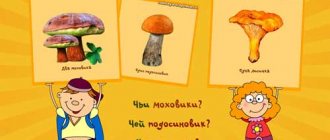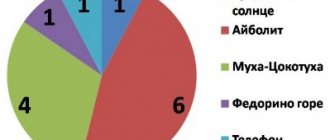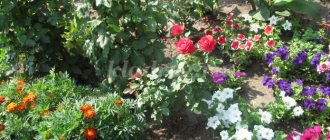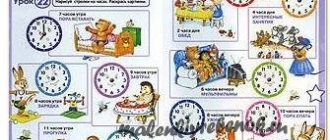Summary of GCD in the junior group for speech development “Dishes”
Summary of educational activities for speech development for children of primary preschool age.
"Dishes"
Program content: Teach children to make simple sentences.
To consolidate children's knowledge about dishes and their purpose. Exercise children in operations with words: use in a diminutive form, coordinate nouns with numerals, one-many. Equipment: illustrations, cut-out pictures on the topic.
Move. Children, all of you come to me, stand in a semicircle. Now look at your chairs, what is on them? That's right, these are cut pictures. You need to collect them and name what is drawn on them. Well done. How can we call all these objects in one word? (dishes).
Now listen to the riddles , whoever guesses what it is raises his hand.
When I'm empty, I forget about you, but when I'm carrying food, I won't pass by my mouth? Are they made of glass, intended for Tea, juice, milk? I puff, puff, puff, I don’t want to get warm anymore. The lid rang loudly - Drink tea! The water boiled.
Well done, you solved the riddles very well and quickly, let's see if you can complete the next task, which is called “who is more”, for each correct answer you will receive a chip.
What kind of mug? Beautiful, new…… Pan, what kind?………. Knife, what?….. Frying pan, what?…..
Well done, now let's count who has more chips.
Now let's play an interesting game “1,2,3,4,5” 1-cup, 2-cups, 3-cups, 4-cups, 5-cups. Teapot…….. Plate…… Spoon…. Saucer…. Pot…. Pan….
Also interesting material for younger preschoolers: Summary of a GCD lesson in a junior group on speech development using folklore works “Cat”
Now let's play with our fingers. Finger game “We washed the dishes.” Well done guys played with our fingers well.
Now we get up from our chairs and make a circle. And our game will be called “One Many”
I throw the ball, I say cup, and the one who caught it says cups. Cup, spoon, pan, mug, spoon, knife, plate, glass. Good guys, give me the ball and take your seats.
“What are the dishes for?” What do we drink from? we drink from a mug. What do we eat soup with?…… Where do we pour the soup?….. What do we fry with?…. how do we cut food?….
How many of you can name the dishes we talked about today? Well done. Did you like our lesson? Today you answered my questions very well, and for this I want to give you these medals with these circles drawn on them.
Title: Summary of educational activities in the junior group for speech development “Utensils” Author: Tkacheva Alina Aleksandrovna Position: teacher Place of work: State Public Institution KO KDRS “Warm House” Location: Kemerovo, Kemerovo region, Russia
Date modified: August 18, 2015 Date published: July 25, 2014
Project type: Cognitive and creative. Duration: 1 week. Project participants: Children, teachers, parents. Children's age is 2-3 years. Project goal: To introduce children to dishes. Develop children's cognitive and speech activity through joint play activities. Objectives: To give students a basic understanding of dishes (what they are, what they are used for). Continue to expand students’ understanding of utensils and their use. Preliminary work: - Illustrations of material on the topic: “dishes”. — Reading literature on the topic. - Listening to songs. — Learning finger gymnastics. Project implementation plan. Stages of the project: Stage 1 - preparatory. Creation of a subject-developing environment in accordance with the theme of the project. — Selection of materials and equipment for classes, conversations, games with children. — Selection of methodological literature on the topic. — Reading poetry and literature on the topic. Stage 2 is the main one. — Didactic game: “What’s in the bag?” Speech development: - Conversations: “What kind of dishes are there?”, “Why do we need dishes?” - Reading fiction: K.I. Chukovsky “Fedorino’s grief”, “The Tale of the Saucepan.” Physical development: - Finger gymnastics: “Machine porridge”, “Dishes”, “One, two, three, four.” - Drawing: Topic: “Sun”, - Modeling: Topic: “Let’s decorate a cup”, “Let’s decorate a plate.” - Listening to music and children's songs on the topic: “Kitty stories”, “Clean dishes”, “Cup”. Working with parents: Involving parents together with their children to participate in the topic. Stage 3 is the final stage. Exhibition of drawings. Comprehensive thematic planning: Day of week: Monday:
- Finger gymnastics: - Porridge machine. - Dishes. - One two three four. Purpose: To develop fine motor skills and attention in children. Do the exercise together, synchronously.
- Reading a fairy tale: K.I. Chukovsky “Fedorino's grief.” Goal: Develop memory. Explain the importance of washing dishes. Talk through the characters in sequence, who follows whom.
- Modeling: Topic: “Let’s decorate a cup.” Goal: We continue to teach children to work with plasticine, teach them to be careful in their work, and to roll smooth balls. We repeat the main colors. We develop fine motor skills of the hands. Distribute the balls evenly throughout the cup without going overboard. Tuesday:
- Listening to children's songs: “Clean dishes”, “Cup”. Goal: Listen carefully to a piece of music, which music is happy or sad?
- Conversation: “What kind of dishes are there?” Goal: To teach children to recognize and learn what kind of dishes there are and what they are needed for.
- Didactic game: “What is in the bag?” Goal: To develop children’s imagination, tactile contact, and to pronounce each object taken out of the bag.
- Coloring books on the topic: Purpose: To teach accuracy, to color without going beyond the outline. Repeat utensils. Wednesday:
- Drawing: Topic: “Sun”. Goal: To develop in children the ability to draw using the non-traditional “fork” technique. Strengthen children's knowledge about colors (red and yellow). Develop the child's creative abilities. Cultivate accuracy in work. 2.Reading a fairy tale: Folk tale “The Tale of the Saucepan.” Goal: Develop memory. Instill a love of cleanliness and clean dishes.
- Finger gymnastics: - Porridge machine. - Dishes. Thursday:
- Modeling: Topic: “Let’s decorate the plate.” Goal: To introduce children to the non-traditional sculpting technique - plasticinography. Strengthen the ability to roll plasticine into balls and sausages. Develop fine motor skills of the hands. Cultivate an interest in modeling. Develop the child's creative abilities.
- Finger gymnastics: - Porridge machine. - Dishes. -One two three four.
- Conversation: “Why do we need dishes?” Goal: To teach children to recognize and learn what kind of dishes there are and what they are needed for. Teach careful handling of dishes. Friday:
- Didactic game: “Name the dishes.” Goal: Know and name utensils and what they are needed for. Repeat the name periodically for better memorization.
- Reading poetry: V. I. Miryasova “Dishes”. Goal: Develop memory. Remember the name of the dish in poetic form. Introduce children to creativity.
- Drawing: Topic: “Decorate the plate.” Goal: Develop fine motor skills of the hands. We teach you to color carefully without going beyond the outline. Introducing wax crayons to children. We repeat the geometric figure “circle”. We repeat the main colors. The result of the project: - The children had a desire to display what they saw using drawing. — The children learned more about utensils and their uses. — The children learned new pieces of music. — Children have become more careful with utensils. Project product:
- Children's drawings.
- Children's fakes.
- We learned a lot of new interesting information about cookware and its use.
Application: Finger gymnastics: “Machine porridge.” - Masha cooked porridge, (the children stir with their index finger in their left palm) - Masha fed everyone porridge. - Masha put the porridge - For the cat - in a cup, (they bend one finger at a time on their left hand) - For the bug - in a bowl, - And for the cat - in a large spoon. - In a bowl for hens, chicks - And in a trough for piglets. - I took all the dishes, (unclench my fist) - I gave away everything down to the crumbs. (blow the crumbs off the palm). "Dishes." - From plates, as one (palms together in front of us “plate”) - We eat soup with spoons. (we represent a spoon, we eat) - We eat cutlets with a fork, (the index and middle finger represent a fork) - The knife cuts us omelettes. (“cut” with a straight palm back and forth). "One two three four." - One, two, three, four, (they hit each other with their fists). — We washed the dishes: (one palm slides over the other in a circle). - And we repeat. "The Tale of the Saucepan."
Once upon a time there was a saucepan. And she had a mistress. Very forgetful... Either she will forget to wash the saucepan and it gets wet in the sink for a long time, then she will forget to put the saucepan in the kitchen cabinet and it gets bored for a long time in the drying room, or she will forget that she put the saucepan in the refrigerator and all the food in the saucepan will go rotten. This is how the saucepan lived with its owner, until one day the owner forgot it on the stove. At first the saucepan was hot, then it became even hotter and its bottom began to burn and turn black. She was already puffing and banging the lid, calling her mistress, but she didn’t hear anything because she was watching TV. Only when the saucepan began to smoke did the hostess come to her senses and turn off the stove. The saucepan was all black. The housewife began to wash the saucepan, scrubbing it with a brush and powder. But I couldn’t wash it, I just rubbed a big hole in the bottom of the poor thing. It was impossible to cook anything else in such a saucepan: no soup, no potatoes, no compote. And the housewife threw the saucepan into a landfill. When we pass by, we will definitely see a lonely saucepan with holes in it and remember that there is no need to forget saucepans on the stove! End.
A thematic selection of games and exercises on the topic “Dishes”.
Goal: To expand children’s knowledge about dishes and their purpose. Objectives: To develop children’s ability to name a piece of glassware and perform possible actions with it. To consolidate knowledge about color, size, quantity. To develop the ability to distinguish non-speech sounds: hitting plastic, wood, metal with a spoon, ceramics. Replenish children's vocabulary on the topic. Develop memory, attention, fine motor skills, coordination of movements.
Equipment: “Wonderful bag” with doll utensils: saucepan, cup, plate, spoon, frying pan, knife, kettle. Wooden, plastic, ceramic, metal plate. Plates in yellow, red, green and blue. Toy products: green cucumbers and pears, red apples, yellow pears and corn, blue eggplants and grapes. Sheets of paper with a drawn table, plate and napkins.
Didactic games on the topic “Dishes”
Didactic games on the topic: TABLEWARE
Goals:
- Development of visual attention, ability to correlate colors.
- Activation of the dictionary on the topic.
- Development of fine motor skills of the fingers.
The teacher invites the children to choose from the utensils placed on the table those that are needed for tea drinking. The children’s task is to set a table for tea with a blue napkin (blue dishes are chosen); work with other colors is carried out in a similar way.
Goals:
- Development of auditory attention.
- Formation of logical thinking and phrasal speech.
The teacher says that mother is very tired, invites the children to help her wash and dry the dishes, and clarifies which dishes are washed (dirty) and which ones are dried (wet). Then the teacher calls: WET PLATE, the children answer: WE WILL WIPE UP; teacher - DIRTY PAN, children - WE WILL WASH, etc.
Goals:
- Development of visual attention and memory.
- Activation of the dictionary on the topic.
Practical use of a simple sentence.
On the table in front of the children are cards with pictures of dishes or doll dishes (up to 5 items). The teacher examines and names it together with the children. Then he invites the children to close their eyes - to “rest”, and removes one object. When children open their eyes, they name which dish “broke.” You can put away unbreakable dishes, drawing the attention of children to the fact that this item cannot be broken.
Goals:
- Activation of the dictionary on the topic.
- Formation of the diminutive form of nouns in the singular.
Game “Three Bears”: Three bears came to the kitchenware store. Children are sellers. They offer the bears dishes according to their size, and tell why the little bear needs a plate, and the big bear needs a plate.
Game situation “What’s in the bag?”
- Guys, today there is something interesting for you in a wonderful bag. Lower the handle and take it out. Pot, kettle, frying pan, plate, spoon, cup, knife. All these items can be called in one word - dishes.
Didactic exercise “What is this?”
This is a saucepan. You can cook soup in it. This is a plate. You can put food in it. This is a spoon. You can use a spoon to scoop up food and put it in your mouth. This is a cup. You can pour tea into it and drink it. This is a knife. They can be used to cut bread. This is a frying pan. You can fry cutlets on it.
Didactic game “Put the food on plates”
- Look what products we have: green cucumbers, red apples, yellow pears, blue plums. You need to place these products on plates of the same color.
Applique and modeling “Tea set”
— There is a table in front of you (drawing).
- Show me where the plate, large napkin, and small napkins are on the table. How many large napkins? One large napkin. How many small napkins? Two small napkins. Take the boxes and see what's in them. Teapot and cups.
- How many cups? Two cups. How many teapots? One kettle. Place napkins, teapot and cups. There is only one kettle and it is large, so you put it on one large napkin. There are two cups and they are small, so you placed them on two small napkins. Now glue the teapot and cups.
“Now it would be nice to make some bagels for tea.” Take plasticine and roll it out into a thin sausage. Take it by the ends with both hands and wrap it into a ring. Connect the ends. It turned out to be a bagel. Place it on the plate and press down with your palm. Sprinkle poppy seeds on top and press with your finger. Make another bagel in the same way.
Didactic game “What’s missing?”
— There are dishes in front of you: a saucepan, a cup, a spoon, a plate. Remember them. Now I will cover the dishes with a handkerchief, and when I open it, something will be missing. What is missing?
Breathing exercise “Shoo, fly, fly away”
(Performed to the song of the same name).
— A fly flew in and landed on the dishes. - Shoo, fly, fly away! You have no business doing anything on our dishes. Blow on the fly to make it fly away. (Cut out drawings of flies are distributed to the children. The exercise is repeated several times).
Finger gymnastics “Helper”
Our Antoshka washes the dishes. (Rub your palms apart)
Washes fork, cup, spoon. (Extend your fingers from the fist, starting with the little finger)
I washed the saucer and glass. And he closed the tap tighter. (Imitating hand movement)
Game with clothespins “Fork”
- Here is a fork without tines. Make tines on the fork using clothespins.
Didactic game “Setting the table”
- In front of you in the picture there are dark spots - shadows. You need to place a suitable shaped dish on top of each shadow: plate, fork, knife, spoon.
Didactic game “Sorting dishes by size”
We washed the dishes clean. We didn’t forget to dry them: Cups and saucers stand in a row And sparkle in the sun.
— Make a pyramid of cups. Then stack the cups on top of each other.
Musical and rhythmic exercise “We are clinking dishes”
Children make sounds using various utensils to the song “We Clink the Dishes.”
Finger painting "Pan"
— Color the pan: put a fingerprint in the empty circles, and paint over the stripes.
Reading the poem "Dishes"
Girl Irinka was putting things in order. Girl Irinka said to the doll: “The napkins should be in the napkin holder. There should be oil in the oil can. There should be some bread in the bread bin. What about salt? Well, of course, in a salt shaker!”
Bas-relief modeling “Decorate the cups”
The cups are new for Mitya. So that he can drink tea, milk and lemonade. We need to decorate the cups.
Pinch off pieces of plasticine and roll into balls. Apply to the cup and press.
Musical and rhythmic exercise “The bear clinks with a spoon”
(Performed to the song of the same name).
Construction “We are waiting for guests”
“The nesting dolls are going to come visit us.” The nesting dolls are small and it won’t be possible to seat them at our large table, so we need to make small tables and chairs for the nesting dolls. Take a cube, place it in front of you, and place a brick on top of the cube. Like this. The result is a table. Now let's make a chair. Place it near the table, and place a brick behind it. Like this. (Vertical). The result is a chair with a back. And here are the nesting dolls! Have them sit on small chairs. And put the dishes on the table.
Examining plates made from various materials
- Here are the plates in front of you. Let's count them. One two three four. How many plates are there in total? Four plates. All plates are different. Here is a ceramic plate that is well known to everyone. Tap it with a spoon and listen to the sound you get. Here is a metal plate. Tap the spoon on it too. Here is a plastic plate. Tap it. But the plate is wooden. Knock on this plate too.
Didactic exercise “Tricky spoon”
“We’ll play with the spoon and name the dishes.”
Close your eyes, come on, guess which plate the spoon is knocking on.
Didactic game “Cut into two halves”
Using plastic knives, children “cut” vegetables into halves (secured with Velcro).
— How many parts did you cut your product into? Let's count: one, two. You cut it into two halves.
Modeling salt dough “Pancakes in a frying pan”
- Roll out the dough straight into a thick sausage. Cut the sausage into pieces with a knife. Squeeze each piece between your index finger and thumb, place it on the pan and press.
Exercise “Cooking lunch”
— There are dishes in front of you: a pot and a frying pan. Take the food, put it in a pot or pan and put it on the stove.
Didactic exercise “Folding napkins”
- Let's fold the napkins beautifully into a glass.





